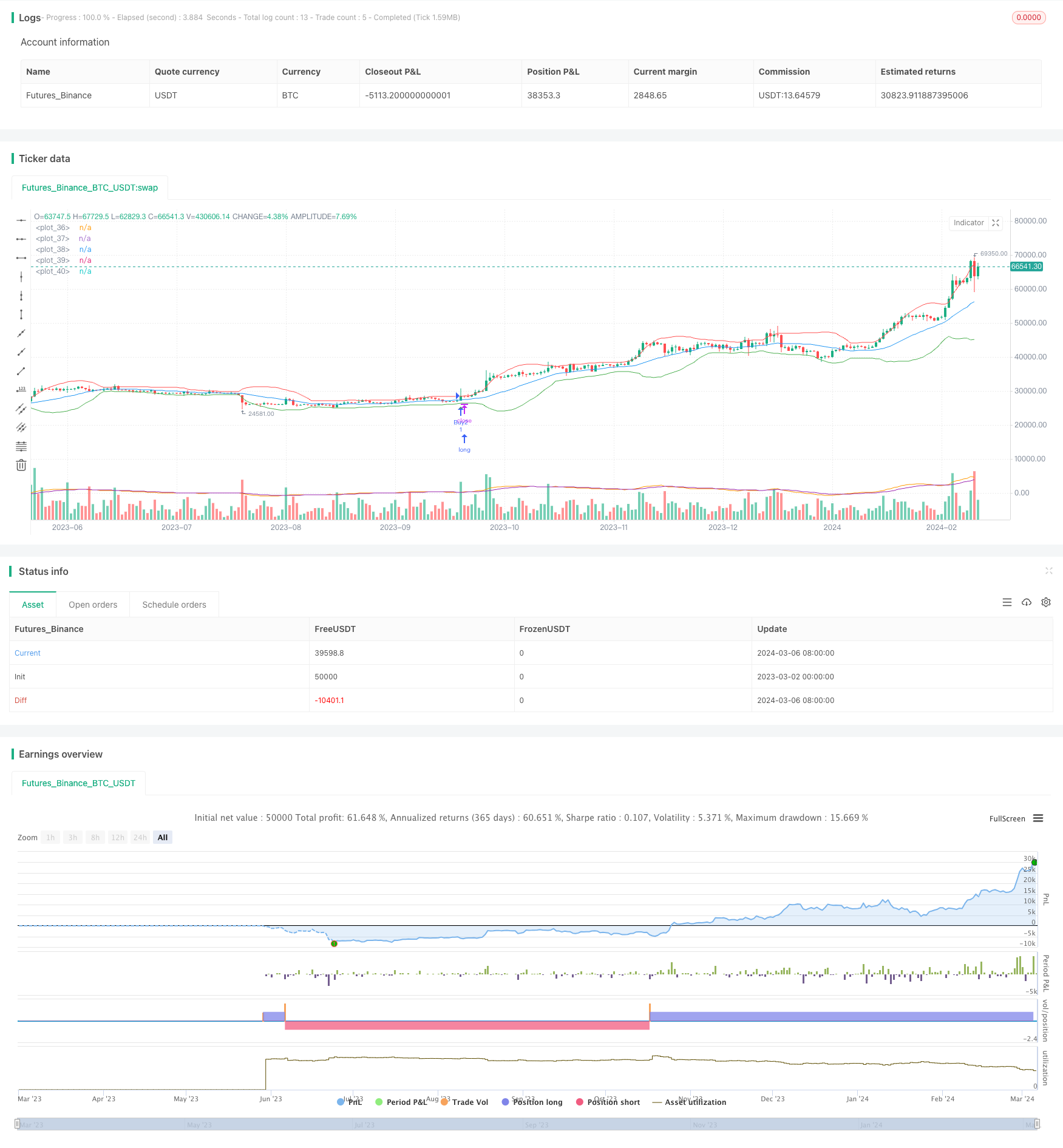
策略概述
该策略结合了多阶段布林带和MACD指标,通过识别价格与布林带上下轨的交叉以及MACD指标的交叉信号,在不同的市场条件下执行不同的交易策略。当价格突破布林带上轨且MACD出现上穿时,策略开多头仓位;当价格突破布林带下轨且MACD出现下穿时,策略开空头仓位。该策略旨在捕捉市场的趋势性机会,同时利用MACD指标的交叉信号确认趋势的有效性,以提高交易的胜率和盈利能力。
策略原理
该策略的核心原理是利用布林带和MACD指标的交叉信号来识别市场的趋势性机会。具体来说:
布林带由中轨、上轨和下轨组成,分别代表了价格的移动平均线、上方标准差和下方标准差。当价格突破布林带上轨时,表明市场可能进入强势上涨趋势;当价格突破布林带下轨时,表明市场可能进入强势下跌趋势。
MACD指标由两条指数移动平均线(EMA)的差值(即MACD线)和MACD线的9日EMA(即信号线)组成。当MACD线上穿信号线时,表明市场可能进入上涨趋势;当MACD线下穿信号线时,表明市场可能进入下跌趋势。
该策略结合了布林带和MACD指标的交叉信号,当价格突破布林带上轨且MACD出现上穿时,开多头仓位;当价格突破布林带下轨且MACD出现下穿时,开空头仓位。这种多重条件的交易信号可以有效提高交易的准确性和可靠性。
此外,该策略还引入了ATR(平均真实振幅)指标,用于衡量市场的波动性。当价格突破布林带上轨且高于中轨+ATR时,或者当价格突破布林带下轨且低于中轨-ATR时,策略才会开仓。这个额外的条件可以进一步确认趋势的强度,避免在波动较小的市场中频繁交易。
策略优势
趋势跟踪能力强:通过布林带和MACD指标的交叉信号,该策略可以有效捕捉市场的趋势性机会,在趋势形成的早期阶段就开仓,从而获得更大的利润空间。
交易信号可靠:该策略采用了多重条件的交易信号,即价格突破布林带、MACD交叉和ATR确认,这样可以有效提高交易信号的准确性和可靠性,减少虚假信号带来的损失。
适应性强:该策略可以适用于不同的市场环境和资产类别,如股票、期货、外汇等,通过调整参数设置,可以优化策略在不同市场中的表现。
风险控制:该策略引入了ATR指标,用于衡量市场的波动性,在趋势不明朗或波动较小时避免开仓,从而控制了交易的风险。
策略风险
参数设置风险:该策略的表现依赖于布林带和MACD指标的参数设置,如果参数设置不当,可能导致交易信号失效或者频繁交易,从而影响策略的收益。因此,需要根据不同的市场特点和资产类别,优化参数设置。
趋势转折风险:该策略主要适用于趋势性市场,如果市场出现频繁的趋势转折或者震荡行情,策略的表现可能会受到影响。为了应对这种风险,可以引入其他技术指标或者信号过滤机制,以识别趋势的有效性。
损失放大风险:该策略在趋势形成的早期阶段就开仓,如果判断失误或者趋势突然反转,可能会导致损失放大。为了控制这种风险,可以设置合理的止损位,或者采用动态的仓位管理方法,如跟踪止损或者加减仓等。
策略优化方向
参数优化:该策略的表现依赖于布林带和MACD指标的参数设置,可以通过历史数据回测和参数优化,寻找最优的参数组合,提高策略的稳定性和收益性。
信号过滤:为了减少虚假信号和频繁交易,可以引入其他技术指标或者信号过滤机制,如趋势指标、均线系统或者时间过滤等,以确认趋势的有效性和持续性。
仓位管理:该策略可以采用更加动态和灵活的仓位管理方法,如根据市场波动性或者趋势强度调整仓位大小,或者采用多级仓位和金字塔加仓等方法,以优化策略的风险收益比。
组合策略:可以将该策略与其他类型的交易策略相结合,如均值回归策略、季节性策略或者事件驱动策略等,以提高策略的适应性和稳定性,实现风险分散和收益增强。
总结
基于多阶段布林带和MACD指标的量化交易策略是一种趋势跟踪型策略,通过布林带和MACD指标的交叉信号以及ATR指标的确认,在趋势形成的早期阶段开仓,以获取更大的利润空间。该策略具有趋势跟踪能力强、交易信号可靠、适应性强和风险控制等优势,同时也存在参数设置风险、趋势转折风险和损失放大风险等。为了进一步提高策略的表现,可以从参数优化、信号过滤、仓位管理和组合策略等方面进行优化和改进。总的来说,该策略适用于追求趋势性机会的交易者,但需要结合市场特点和自身风险偏好,灵活调整和优化策略参数,以获得稳定和可持续的交易收益。
/*backtest
start: 2023-03-02 00:00:00
end: 2024-03-07 00:00:00
period: 1d
basePeriod: 1h
exchanges: [{"eid":"Futures_Binance","currency":"BTC_USDT"}]
*/
//@version=5
strategy("Multi-Stage Bollinger Bands Strategy with MACD", overlay=true)
// Bollinger Bands settings
length = input.int(20, title="Bollinger Bands Length")
src = close
mult = input.float(2.0, title="Bollinger Bands Multiplier")
// MACD settings
macdShort = input.int(12, title="MACD Short EMA")
macdLong = input.int(26, title="MACD Long EMA")
macdSignal = input.int(9, title="MACD Signal Smoothing")
// ATR settings
atrLength = input.int(14, title="ATR Length")
// Calculate Bollinger Bands
basis = ta.sma(src, length)
dev = mult * ta.stdev(src, length)
upper = basis + dev
lower = basis - dev
// Calculate MACD
[macdLine, signalLine, _] = ta.macd(close, macdShort, macdLong, macdSignal)
// Calculate ATR
atr = ta.atr(atrLength)
// Entry conditions
longCondition1 = ta.crossover(src, lower) and src > basis + atr and macdLine > signalLine
longCondition2 = ta.crossover(src, basis) and src > basis + atr and macdLine > signalLine
shortCondition1 = ta.crossunder(src, upper) and src < basis - atr and macdLine < signalLine
shortCondition2 = ta.crossunder(src, basis) and src < basis - atr and macdLine < signalLine
// Plot Bollinger Bands and MACD
plot(basis, color=color.blue)
plot(upper, color=color.red)
plot(lower, color=color.green)
plot(macdLine, color=color.orange)
plot(signalLine, color=color.purple)
// Plot entry signals
plotshape(longCondition1, style=shape.triangleup, location=location.belowbar, color=color.green, size=size.small)
plotshape(longCondition2, style=shape.triangleup, location=location.belowbar, color=color.green, size=size.small)
plotshape(shortCondition1, style=shape.triangledown, location=location.abovebar, color=color.red, size=size.small)
plotshape(shortCondition2, style=shape.triangledown, location=location.abovebar, color=color.red, size=size.small)
// Execute trades
strategy.entry("Buy1", strategy.long, when=longCondition1)
strategy.entry("Buy2", strategy.long, when=longCondition2)
strategy.entry("Sell1", strategy.short, when=shortCondition1)
strategy.entry("Sell2", strategy.short, when=shortCondition2)